Posted by
Mordy Oberstein
In an effort to get everyone to make nice and play together well in the sandbox, Google is raising the mobile-friendliness stakes. Hoping for liberty and justice for all and in bringing device equality to the universe, Google announced it will increase the weight of mobile-friendliness on page ranking. Starting in May, Google will be adding more weight to its mobile-friendly algorithm upping the ante on the relationship between mobile-friendliness and SERP rankings.

 Woe Is Me, Woe Is Me, Whatever Will I Do?
Woe Is Me, Woe Is Me, Whatever Will I Do?
Well, chances are you are already mobile-friendly not because Google told you to be, but because your bottom line counts on it. After all, forecasters predict that mobile ad revenue will not only continue to rise but will leap other sources of revenue like Superman leaps tall buildings… in a single bound. Like the Man of Steel, if you want your business model to be bulletproof, you simply need to pay attention to your mobile groupies, i.e. customers/users.
Google recognizes the fact that most of us are on the path towards mobile-friendliness redemption by noting that if your site is already built in a mobile-friendly manner “you will not be impacted by this update.” It would seem then, and in contradistinction to the original roll-out, this update is not a shove towards mobile-friendliness, but more a gentle nudge.
The Long and Winding Road Towards Mobile-Friendliness
When Google initially released the algorithm in April 2015, fears of it destroying page rankings spread like wildfire and a general sense of mobilegeddon pervaded. With the update, is there a need for concern of mobilegeddon’s second coming? Come May, will your page ranking plummet in an instant?
Google is expected to roll out the new algorithm in a slow and steady manner. Like the original roll-out of the algorithm, the new update is page-level. Which means then, it will take a bit of time for each page out there in the deep abyss of the web to be read by Google.
My bottom-line prediction… it’s more likely that an alien infant will be sent rocketing through space, crash land on Earth, be raised on a farm, and eventually discover immense superhuman powers, then it is for this update to be some sort of mobilegeddon.
Putting on a Mobile Happy Face
The obvious question of course is, what is Google looking for? What differentiates a mobile-friendly site from its abrasive counterpart?
Well, there a few things that stand out:
A Need for Speed: It’s never good when a page is slow to load, this is equally applicable for mobile usage as well. In fact a few months back Google launched the AMP (Accelerated Mobile Page) project to help raise the standards of mobile web browsing.
Size Counts: Font size that is. If Google detects your text is a bit too small to read no magic pill will help your rankings.
If the Shoe Fits: If the page content fits, Google will let you wear a higher page ranking. If Google should notice that a page’s content does not fit horizontally on the screen and the user needs to pan sideways in order to see all of the content, you may need to pan vertically to see your page rank. This also means that your page needs to have readable scale when opened on a mobile device.
Plug It In: You want to make sure that your plugins are compatible. Keep in mind that many mobile devices simply don’t support plugins.
Pushing Your Buttons: While you may not want to push someone else’s buttons, you definitely want mobile users to push yours. Have you ever had a hard time clicking on a link or pressing some other sort of tap target when on your phone because everything was too smooshed together? Having users face a tapping obstacle course is not going to bode well for your rankings with the big “G” (Google, not the other big “G,” not sure He really cares one way or the other about this one).
Apple of Your Eye: It’s important to consider how many people might be viewing your site from an iPhone. Paying close attention to Apple’s Creating Compatible Web Content Standards will help ensure that all of those trendy Apple users are trending over to your highly visibly ranked site.
I was actually hard-pressed to find an example of a site that fails every test, but a search for old websites led me to this and it came close…
Keeping Your Friends Close and Your Mobile-Friends Closer
Great, so you’re not panicking about the increased weight Google is going to assign to mobile-friendliness and that’s a good thing. However, panic or not, it’s certainly and obviously important to ensure that your site is completely mobile-friendly. But how do you know the pages on your site are actually mobile-friendly? Remember, this is a page-by-page thing… so even if you think your homepage is in “mobile” order, you still need to optimize every page on your site that you want mobile users to access – especially if you have an e-commerce site.

The mobile-friendly tests in this post are courtesy of our On-Page Keyword Optimization tool that features a full SEO analysis in addition to a page’s mobile-friendliness. Simply drop in the page’s URL and a content keyword into the tool and scroll down for your comprehensive on-page audit. The tool will analyze all of those ever so important traits such as font legibility, the size and proximity of your links and buttons, the use of incompatible plugins, etc.
 In fact, you’ll even get a clear and concise mobile-friendliness score that you can reference. Perhaps most importantly, if your page should have a mobile-friendly hiccup, the On-Page Keyword Optimization tool will highlight the exact problem and point you in the direction of how to take precise and effective corrective measures.
In fact, you’ll even get a clear and concise mobile-friendliness score that you can reference. Perhaps most importantly, if your page should have a mobile-friendly hiccup, the On-Page Keyword Optimization tool will highlight the exact problem and point you in the direction of how to take precise and effective corrective measures.
More than that, we offer fully comprehensive monitoring that enables you to analyze your mobile SEO performance. With these services you can (among other things):
- See your mobile SEO ranking
- Identify mobile traffic conversions or transactions
- Track your mobile effectiveness in specific locations and in comparison to local competitors
Having a knowledge of your mobile-friendliness is all well and good, but at the end of the day being mobile-friendly is a means to an end. It’s important to track how close you are to that end as well – you should ensure that your mobile-friendliness is taking you to the places you want to go.

